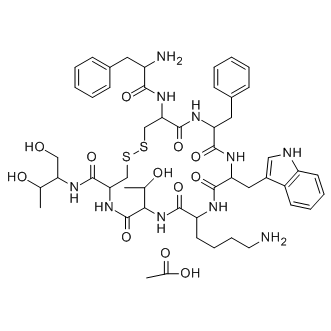
Octreotide acetate
CAS No. 79517-01-4
Octreotide acetate( SMS-201995 )
Catalog No. M15977 CAS No. 79517-01-4
An octapeptide that mimics natural somatostatin pharmacologically, that is 200 times more potent than somatostatin.
Purity : >98% (HPLC)
 COA
COA
 Datasheet
Datasheet
 HNMR
HNMR
 HPLC
HPLC
 MSDS
MSDS
 Handing Instructions
Handing Instructions
| Size | Price / USD | Stock | Quantity |
| 5MG | 27 | In Stock |


|
| 10MG | 42 | In Stock |


|
| 25MG | 63 | In Stock |


|
| 50MG | 84 | In Stock |


|
| 100MG | 123 | In Stock |


|
| 200MG | 177 | In Stock |


|
| 500MG | Get Quote | In Stock |


|
| 1G | Get Quote | In Stock |


|
Biological Information
-
Product NameOctreotide acetate
-
NoteResearch use only, not for human use.
-
Brief DescriptionAn octapeptide that mimics natural somatostatin pharmacologically, that is 200 times more potent than somatostatin.
-
DescriptionAn octapeptide that mimics natural somatostatin pharmacologically, that is 200 times more potent than somatostatin; has also been shown to produce analgesic effects, most probably acting as a partial agonist at the mu opioid receptor.(In Vivo):Octreotide-treated groups show a significant reduction in the tumor volume when compared with saline group. Octreotide-PPSG (1.4 mg/kg, i.p.) shows greater antitumor effect than Octreotide-soln (100 μg/kg, i.p.). Octreotide-treatments results in significant inhibitory effect on the expression levels of SSTR2 and SSTR5 in primary HCC-bearing rats compared with the saline group. Octreotide-PPSG appears to inhibit the expression of SSTR2 and SSTR5 to a greater extent than that of Octreotide-soln treated group. A test dose of octreotide acetate significantly decreases the serum gastrin level to approximately one third of the baseline in 2 hr and the effect lasted approximately for 6 hr. On day 21, treatment with sustained-release formulation of octreotide acetatea (5 mg intramuscular, q 4 wk) is initiated.
-
In Vitro——
-
In VivoOctreotide-treated groups show a significant reduction in the tumor volume when compared with saline group. Octreotide-PPSG (1.4 mg/kg, i.p.) shows greater antitumor effect than Octreotide-soln (100 μg/kg, i.p.). Octreotide-treatments results in significant inhibitory effect on the expression levels of SSTR2 and SSTR5 in primary HCC-bearing rats compared with the saline group. Octreotide-PPSG appears to inhibit the expression of SSTR2 and SSTR5 to a greater extent than that of Octreotide-soln treated group. A test dose of octreotide acetate significantly decreases the serum gastrin level to approximately one third of the baseline in 2 hr and the effect lasted approximately for 6 hr. On day 21, treatment with sustained-release formulation of octreotide acetatea (5 mg intramuscular, q 4 wk) is initiated.
-
SynonymsSMS-201995
-
PathwayGPCR/G Protein
-
TargetSomatostatin Receptor
-
RecptorSomatostatinReceptor|Somatostatin
-
Research AreaOther Indications
-
IndicationOther Disease
Chemical Information
-
CAS Number79517-01-4
-
Formula Weight1079.291
-
Molecular FormulaC51H70N10O12S2
-
Purity>98% (HPLC)
-
SolubilityDMSO: ≥ 29 mg/mL
-
SMILESCC(C1C(=O)NC(CSSCC(C(=O)NC(C(=O)NC(C(=O)NC(C(=O)N1)CCCCN)CC2=CNC3=CC=CC=C32)CC4=CC=CC=C4)NC(=O)C(CC5=CC=CC=C5)N)C(=O)NC(CO)C(C)O)O
-
Chemical NameL-Cysteinamide, D-phenylalanyl-L-cysteinyl-L-phenylalanyl-D-tryptophyl-L-lysyl-L-threonyl-N-[(1R,2R)-2-hydroxy-1-(hydroxymethyl)propyl]-, cyclic (2→7)-disulfide, acetate (1:?)
Shipping & Storage Information
-
Storage(-20℃)
-
ShippingWith Ice Pack
-
Stability≥ 2 years
Reference



-
Pasireotide L-aspart...
A potent, stable cyclohexapeptide somatostatin mimic that exhibits unique high-affinity binding to human somatostatin receptors.
-
L-803087
L-803087 is a potent and selective agonist of the growth inhibitor sst4 receptor with a Ki value of 0.7 nM for sst4, demonstrating over 280-fold selectivity compared to other growth inhibitory receptors.
-
Cortistatin-14
Cortistatin 14 is a neuropeptide expressed in inhibitory neurons of the cerebral cortex. Depresses neuronal activity, and induces slow-wave sleep, likely through antagonism of acetylcholine. It is structurally and functionally similar to somatostatin 14. Competes with somatostatin 14 for binding of somatostatin receptors (IC50s=5, 0.09, 0.3, 0.2, and 0.3nM for receptors sst1-5, respectively).



 Cart
Cart
 sales@molnova.com
sales@molnova.com


